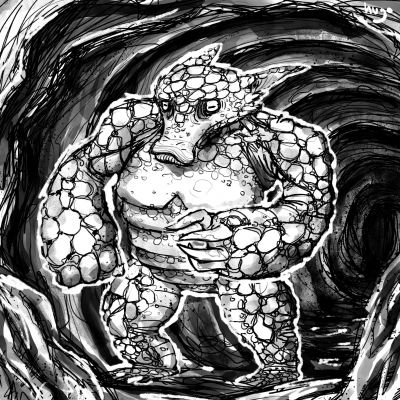Manidae

Forgotten Labourers
Origins
During the golden era of Deumana rule, the cunning overlords came to realise that the most efficient machinery was not mechanical, but organic. Mechanics require repairs, a power source, updates, upgrades, and monitoring. They are unable to solve simple abstract problems, nor do anything outside of what they were designed to do. Organic beings, on the other hand, can self-repair, perform and supervise complex tasks, use reasoning and judgement to problem-solve, feed and maintain themselves, and be reared to monitor each other. They can be reared as intelligent, organic machines.
With this mindset the Deumana created much of the Fauna and Races of Lume, the Manidae were no exception. Splicing various extinct and existing Fauna and Flora, they cultivated a large and powerful workforce, directed in units to undertake mining, construction and demolition tasks. It appears that their usefulness was short-lived, extant Library records indicating that by the end of the era Manidae were considered outmoded and inefficient; to be overlooked and later forgotten in the vast caverns of subterranean Lume. When the ancient Deumana met their downfall in the latter phase of the Schism, the Manidae remained insulated within their stony communities. For cycles the other Races were unaware of their survival; in time, stories began circulating through trade routes and traveling entertainers of the appearance of intelligent bipedal warriors. When rumours reached the Arch-Academic, it was noted the descriptions sounded like those of the forgotten Race, and was verified by the long-lived Gardeners. The Slenders doggedly sought them out, and with great difficulty made contact, coaxing them to emerge from the depths of their colonies. This convergence of Races was not without incident, and has come to be known as the The Great Altercation.
By then much time had passed, and the Manidae had adapted. These Manidae were smaller than the Gardeners remembered, reduced from roughly the size of a log cabin to that of an upright bear. It is believed this helped preserve resources and allowed them to better navigate their sinuous tunnels. They had also changed socially, dividing themselves into different classes to better administer their developing and isolated civilisation. Once hatched, the larger percentage were destined for grunt work in the mines, growing large, strong, and encouraged to be docile. A small fraction, roughly 10%, formed the upper administrative and aristocratic class. Slim, well-educated and calculating, their status quo was maintained by the third faction, the soldier class. Representing roughly 25% of the populace, these grew as broad as the miners, were trained in warfare and soldiering, and permitted to grow their diamond-hard talons to deadly sizes. In this fashion, their race maintained a stable, albeit brutish order; the administrative class ordered, the guards kept the laborers in line and guarded the borders, while the workers mined and cultivated the basis of their subsistence and trade. They call their system the Tripod, professing that each class supports the whole. Perhaps ironically, our records indicate it was this manner of class segregation that led to the development of the ancient and terrible Deumana.
Culture
Having developed in isolation, their civilisation can be challenging for members of the other Races. In many ways Manidae society resembles a hive more than a community, with accompanying views regarding their ethics, legal system, and aspirations. Their society leans towards totalitarianism, they evidence little emotional connection to each other, even towards their young; juveniles are regarded as a necessary inconvenience. In a tragic twist of fate, they appear to remain shackled to the concept they were bred for. Servitude. The Manidae value different commodities than the Folk, made all the more apparent when Folk approach them for trade. Their laws reflect their principles of a goal greater than themselves, and breaking their strict codes elicits retribution or ostracization. Much can be also be discerned from their Recreation, Philosophy, Architecture and Textiles. The Manidae have a complex and secretive method of procreation, which we understand engages three of their species, and involves crystalline eggs coined paragons. This area of study is highly speculative; further research is required, and warrants an expedition.
Diplomatic Relations
The Manidae have a long-standing feud with the Dunefolk and Desert Peoples, the origins of which are still debated. Slenders educated in these Races hypothesize that the cultures met prior to identification by the Slenders, with negative consequences. The feud is complicated and nuanced, though can be summarized by three key points. The Sunfolk steal from the Manidae, specifically targeting their breeding crystals; the latter race consider theft an offence punishable by death. The Desert Peoples also run into land-grab issues with the Manidae, as the areas they mine also hold ancient technology the Desert People seek. Finally, their cultures are starkly contrasted, and the borders of their regions overlaid, which inevitably leads to feuds. Historians argue The Great Altercation never truly ended.
Despite persistent rumours, it is misleading to suggest that the Manidae are habitual cannibals. Rather, they engage in the practice only rarely; sources suggest this includes special ceremonies are conducted to commemorate their survival underground during the Schism, and when stores of game are dangerously low. In either case it appears that to be selected constitutes a great honour.
SPOILER: In Drethen's era, there are ripples of rebellion and revolution among the Manidae, having been influenced by the interaction with Slenders, Singers of Silica, and travelers like Drethen & Co. They take the opportunity after the War for the Living to rise up while their leadership is still reeling, and restructure their society more democratically.
